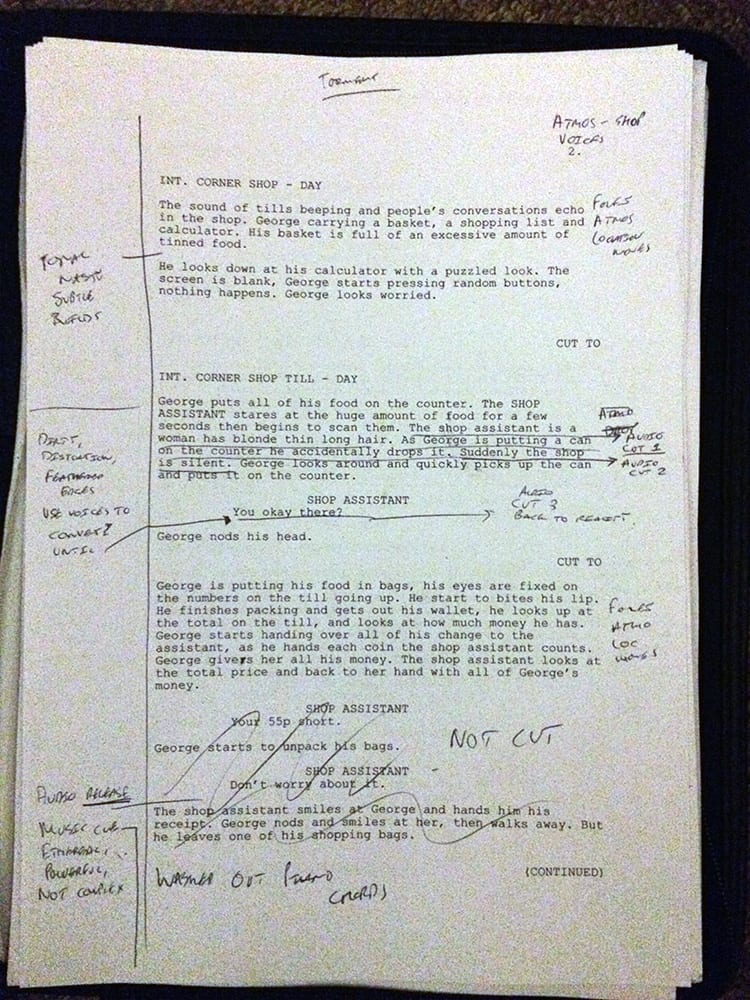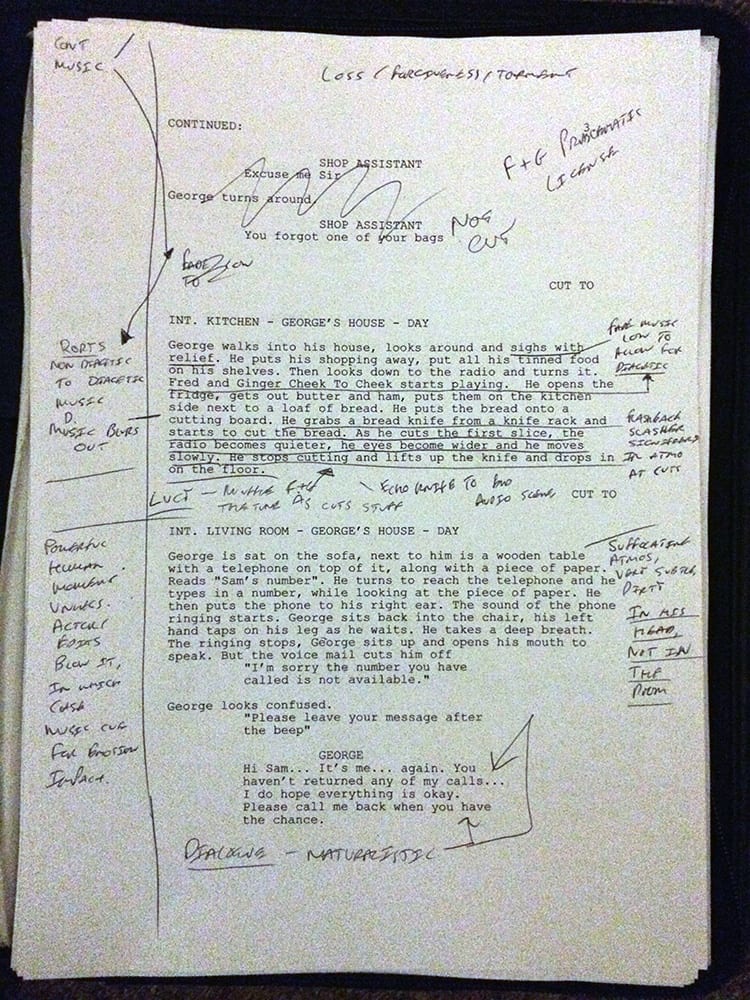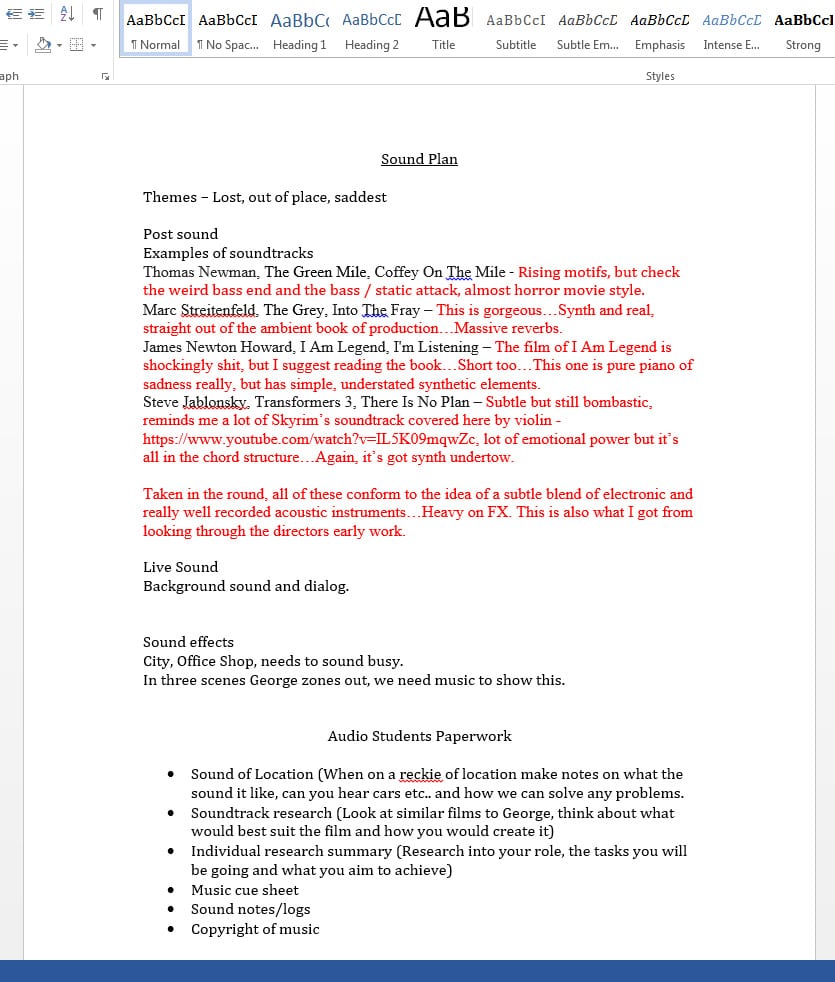Below are the first few pages of the final audio plan for our work on ‘George’, as used to present our overview to the film-makers –
Month: October 2015
SUPPORTING – Director’s Audio Guidance
ROLE DIARY – ‘George’ Early Planning and Liason
Our group agreed to work on the film ‘George’ roughly three weeks ago, and the main priority over this period has been to work with the film crew to solidify a shooting schedule which will enable us to properly cover the requirements for location sound for the project. This has been largely achieved by liason between myself and the director as single points of contact for managing our respective teams, and we now have the dates and our equipment and availability confirmed for shooting and location recording.
We also insisted that a rough schedule for post production be agreed, which has enabled me to plan and book facilities we will require for post well in advance.
Since we are required to score, compose and record the music for the piece as well as managing location recording and all post production in a relatively short timeframe, I am aware we should begin work on music and atmosphere prior to the beginning of filming as the schedule is tight. After receiving some basic guidance from the director on her requirements and an early draft of the script, we arranged several meetings with the crew to thrash out some more specific plans for the film’s audio.
The first part of this process was the discussion of the themes and motifs deriving from the story and script, and to what level these can or should be represented in the audio. In this case, the film addresses loss, sadness, institutionalisation and the rights and wrongs of judging others.
We were also informed that the director required ‘a lot of music’ which – practically speaking in the context of a short film, means ‘more music than not’ – and that this music should be rooted in a ‘classic’ score utilising acoustic instruments and tones, but should retain an unsettling, electronic edge. It is immediately apparent that this will constitute the largest and most challenging aspect of the project if we are to create the music to high standard, and that the 7 week timeframe for completing the entire project will mean we must begin the composition almost immediately, and before even basic rushes of the picture are available. This is unfortunate, and was specifically flagged as something which can cause problems by professional music supervisor Lol Hammond in a guest lecture to the AUP contingent this year, but is unavoidable if we’re to complete the job on time.
To this end, we requested further reference tracks and films from the director, and attempted to get to the heart of what works for her about these pieces. Since it is difficult to convey complex ideas in music and sound we worked to simplify these ideas and looked for ways to bridge the meaning the director intended to convey into music.
The information collected during this process allowed us to set about constructing a basic outline of our audio plan with reference to the script, roughly split into the areas of music – foley – atmosphere, whilst also taking the opportunity to document as many of the ‘physical’ (translating roughly to foley – atmos – dialogue) aspects of the script as possible, and arranged all this into several rough planning documents, with each group member concentrating in a particular area as dictated by their chosen role for this project. We checked a number of these ideas over with the director in conference as we worked.
This process of discussion and feedback enabled us to create rough outlines of the arcs of the audio components of the film which we fed back to the film-makers at our final panning meeting a week before shooting commences, which in turn will enable us to begin work on our contribution as early as possible.
——————————————————————————-
KEY POINTS –
How decisions pertaining to overall artistic direction were made, and why. – Contribution + Role
- To manage the post-production workflow and contribute substantially to the sound design, construction and editing of the piece.
Process of liasing with client and discovering their requirements. – Process Management
- To successfully manage the audio team’s interaction with film’s director, editor and producer on a practical and creative level, and ensure the audio team’s work is delivered on time and to a good standard.
654 words
Guest Lecture – Bryan Rudd – Project Case Study – 19/10/15
Bryan Rudd used this lecture to take us through his experience constructing a 5 part radio drama for BBC Radio 7 in 2007 to demonstrate a method by which we might present the details of our own project’s and the learning outcomes we achieve whilst carrying them out.
He reflected in detail on the problems he encountered stepping into the project at the 11th hour, the decisions he took to enable it’s completion and why they were taken, and how some of these translated into the positives or negatives of the piece as broadcast.
A key point, given the high pressure nature of the project he described, was deployment of effective project management and Bryan demonstrated how the constraints of the project and it’s brief effected the direction of research and decision-making, and how this was used in-turn to inform creative decisions such as recording locations, perspective choices and edit selection.
He also highlighted a couple of errors in the final product’s audio and explained his view of the judgement calls or pressures which led to them being missed in the final quality control process.
Given that my role of Supervising Editor in my group’s semester A project is similar in some respects to the multi-role Bryan adopted for this project – in that it entails key creative decisions, project management and research to fulfil both a brief and the artistic vision of the director and that project itself is relatively ambitious given it’s short time-frame – I would expect the case study he discussed to have more relevance than simply a demonstration of his reflection on the subject.
– 264 words
Project Overview + Learning Outcomes
Semester A Audio Project AUP3003M group comprising:
Alice Asbury (Music Supervisor) – http://aliceaudioproject1.blogs.lincoln.ac.uk
Gareth Bailey (Supervising Sound Editor)
Rory Hunter (Location Audio Supervisor) – http://roryhunter.blogs.lincoln.ac.uk/
Project Overview + Film Synopsis:
The Semester A project for the above group is to provide the audio for a 10 – 12 minute short drama created by a group of Media Production students, directed by Lucy Norton.
The following synopsis of the plot was provided by the client – “The film is about an old man (George) who struggles with everyday life tasks, encouraging the audience to sympathise with him. However, through the film there are suggestions that George has a dark and unsettling past that asks the audience to questions exactly how they actually feel about him. The film is based around the themes of judgement, punishment, forgiveness and loss.”
Client Requirements + Timeframe
We are engaged to provide a full score (preferably composed), location field recording of the audio and dialogue on set for roughly 8 days of filming, and full audio post production and editing of the audio, including additional foley and dialogue replacement as necessary.
Filming is due to commence October 26th for a two week period and scheduled to conclude by Sunday 8th of November, and the project audio must be completed and delivered in compliance with BBC audio guidelines by the 17th of December 2015.
We will receive an assembly cut of the film circa 4th of December, and will deliver the finished soundtrack to picture by December 16th leaving time for quality control, final paperwork and submission for all parties before the deadline. Prior to receipt of the assembly cut we will have provided a number of temp music tracks and work in progress for audio atmosphere, as many specific plot devices and scenes edited prior to the assembly cut’s delivery as is feasible which should enable us to deliver scratch mixes of the audio tracks for all or part of the film as required.
Group Aim
- To create and deliver the soundtrack to the film ‘George’ by Lucy Norton, Charlotte Hughes, Shaun Standring and Angelin Selvanathan.
Group Objectives:
- To create an effective musical score and soundtrack that suits the themes of the film and supports the story in a manner concordant with the picture and the preferences of the director.
- To successfully manage and conduct location recording to capture useful dialogue and atmospheres that will form the basis for some sound design aspects of the picture.
- To create believable and relevant atmospheres and sound effects in post production, and edit these into a full soundtrack using foley, location recordings, composed music and replaced dialogue where applicable.
Outcomes as the project’s Supervising Sound Editor:
- To successfully manage the audio team’s interaction with film’s director, editor and producer on a practical and creative level, and ensure the audio team’s work is delivered on time and to a good standard.
- To judge the initial direction of and maintain the consistency of the overall tone of the audio team’s work on the piece, and liase with the director to ensure this is concurrent with their vision of the piece.
- To manage the post-production workflow and contribute extensively to the design, construction, editing and mixing of the audio for the piece.
- To manage the delivery of the soundtrack at various stages of the production along with relevant paperwork, to the director and producer.
Other personal learning outcomes:
- To expand my knowledge of the theory and audio techniques deployed in the films influencing ‘George’, and in drama as a genre more generally.
- To contribute extensively to the practicalities of creating and recording music for, and of recording location sound for the piece.
- To have a good degree of creative involvement in the conception and direction of the soundtrack for the piece.
- To successfully manage a three person team in delivery of the entire soundtrack to a new piece of visual media efficiently.
– 639 words




